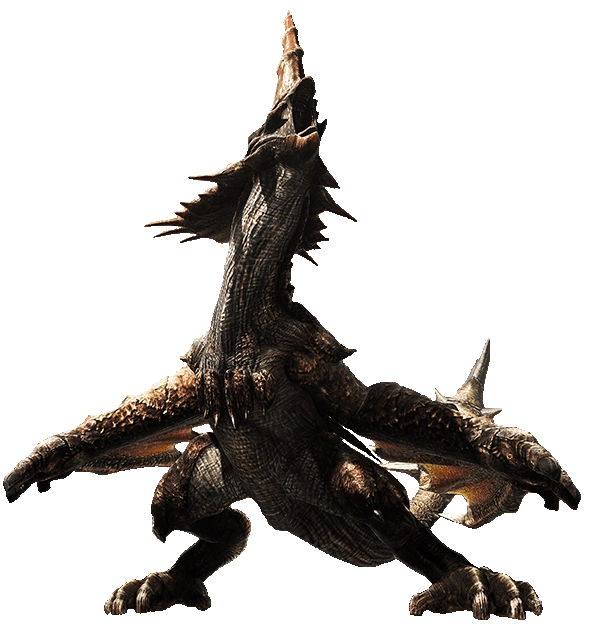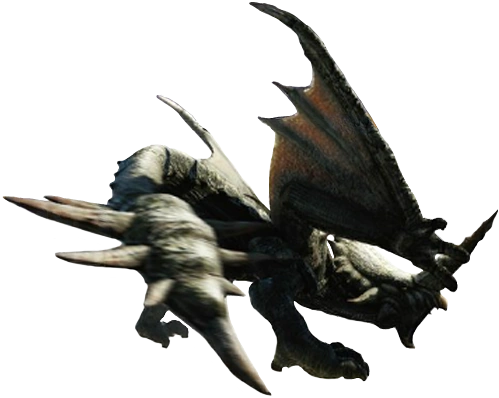 Herbivorous but highly aggressive desert-dwelling bipedal Flying Wyverns that are named for their giant singular nose horn. Monoblos greatly resemble their close relatives the Diablos, possessing the same heavily armored body structure with powerful muscles adapted for digging. Nonetheless, there are a number of differences. Unlike the broad frills of Diablos, Monoblos have elongated frills extending above their head instead of sideways, which are similarly used to push away obstacles while digging. [Their larger frills may help them compensate for their singular nose horn which is not as adapted for digging as the twin horns of Diablos.] These frills have long parietal spikes extending from their edges, with the longest spikes located on the top of the frill. A pair of jugal horns also extend from their cheeks and three pairs of spikes protrude from their armored backplate. These features make them appear more intimidating, and their frills can be flushed with blood especially when enraged. The spikes on their neck frill and back, as well as their giant nose horn have a reddish tinge that is most apparent after they have been properly cleaned. Furthermore, Monoblos have tail clubs similar to that possessed by Rathalos, with four pairs of thagomizer spikes protruding sideways and a singular spike at the tip, instead of the hammer-shaped tail club of Diablos. Lastly, even though Monoblos have a herbivorous diet of cacti similar to Diablos, they have very different beaks. Monoblos has a thinner pointed beak and their mouths have cheeks [which allow them to actually chew unlike Diablos.]
Herbivorous but highly aggressive desert-dwelling bipedal Flying Wyverns that are named for their giant singular nose horn. Monoblos greatly resemble their close relatives the Diablos, possessing the same heavily armored body structure with powerful muscles adapted for digging. Nonetheless, there are a number of differences. Unlike the broad frills of Diablos, Monoblos have elongated frills extending above their head instead of sideways, which are similarly used to push away obstacles while digging. [Their larger frills may help them compensate for their singular nose horn which is not as adapted for digging as the twin horns of Diablos.] These frills have long parietal spikes extending from their edges, with the longest spikes located on the top of the frill. A pair of jugal horns also extend from their cheeks and three pairs of spikes protrude from their armored backplate. These features make them appear more intimidating, and their frills can be flushed with blood especially when enraged. The spikes on their neck frill and back, as well as their giant nose horn have a reddish tinge that is most apparent after they have been properly cleaned. Furthermore, Monoblos have tail clubs similar to that possessed by Rathalos, with four pairs of thagomizer spikes protruding sideways and a singular spike at the tip, instead of the hammer-shaped tail club of Diablos. Lastly, even though Monoblos have a herbivorous diet of cacti similar to Diablos, they have very different beaks. Monoblos has a thinner pointed beak and their mouths have cheeks [which allow them to actually chew unlike Diablos.]
Like Diablos, Monoblos are feared since they are extremely territorial and aggressive towards other monsters in their habitats, even herbivores, since food sources are limited in the desert. When provoked, they will release an ear-splitting screech of a roar. They will even huff black smoke if truly enraged, similar to Diablos. As mentioned above, they will also flush their frills with blood. Genprey packs and their Gendrome alphas, as well as Cephalos packs and Cephadrome leaders often fall victim to the their vicious rampages. Even large predators like the ferocious Tigrex give them a wide berth. If not charging at their foes at high speed with their powerful legs, they tunnel underground to ambush enemies from below. They will use their spiked tail clubs in combat as well. Despite that, it is worth noting that Monoblos are said to be less aggressive than Diablos. [It's possible that they're less territorial because their dentition and jaw structure allow them to process their food better and survive with less food.] Monoblos are extremely rare however, [potentially because they are still out-competed by the more aggressive Diablos.] For this reason, Monoblos are only allowed to be hunted by solo hunters to protect them from over-hunting.
Due to their subterranean habits, Monoblos have an excellent sense of hearing but poor eyesight like Diablos. They are similarly highly sensitive to loud sounds like sonic bombs and monster roars, which surprises them and forces them to surface. This disorients and traps in the sand for the time being, but after they find their bearings they will use their wings to take flight in order to free themselves.
During the breeding season, males will flush their frills with blood to attract females and scare off rivals. It's quite probable that males will fight each other over females like Diablos. However, the females do not undergo a major physiological change as seen in Black Diablos.
Instead, Monoblos have a rare Subspecies known as White Monoblos due to their chalk-tinted armor plating. The origins of this Subspecies are unknown, as Monoblos are already rare monsters with a small population. White Monoblos have a harder shell and are more aggressive than normal individuals, capable of chaining charge attacks together and charging faster than normal Monoblos.
